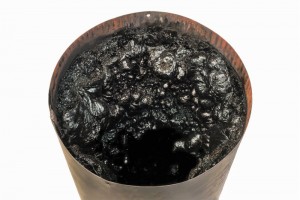Our fireplaces are the focal points of our homes, serving as a gathering place for family and friends and a backdrop for special holiday memories or cozy winter evenings spent around a roaring fire. Because of this, most homeowners take the time to clean and care for their fireplaces throughout the year. However, no matter how much you clean your fireplace there may be a hidden danger lurking in the flue: creosote.
What is creosote?
Although creosote buildup is the primary reason chimneys need to be professionally swept, very few homeowners actually know what it is. Creosote is a natural byproduct created when fuel is burned. While fires from coal, natural gas, pellets, and propane produce small amounts of creosote, it is created in much larger amounts by wood fires.
Having your chimney swept and creosote removed is an important part of chimney maintenance for three reasons. First, creosote is extremely flammable. When it builds up in the flue, creosote can be ignited by stray sparks or embers from the fire; because of this, creosote is the primary cause of chimney fires. Second, creosote can damage your chimney’s flue liner. In addition to being flammable, it is also corrosive. When left in the flue for long periods of time it can harden, making it difficult to remove to the point of needing to replace the entire flue tile. Third, creosote can cause your chimney to stink. Creosote buildup can create a smelly, smoky odor that can permeate your entire home. Creosote chimney odors are often worst in the summertime or during humid weather.
The three stages of creosote
When creosote begins to form in your flue, it can be found in one of three stages. Stage one creosote is the easiest to remove, while stage three represents long term creosote buildup.
- Stage 1: Stage one creosote is typically found in small amounts and described as fluffy or velvety soot. Because of this appearance, it can be difficult to differentiate between creosote and normal soot.
- Stage 2: Stage two creosote is what is most often seen in chimneys. In this stage, creosote creates a crunchy, flaky, or dry layer on the inside of the flue that can be easily removed by a chimney sweep’s special brushes.
- Stage 3: Stage three creosote buildup is the most serious and hardest to remove. Also called glazed creosote because of the thick, glassy layer it forms, stage three is extremely difficult to remove and often damages the underlying flue tiles.
The best way to prevent creosote from reaching stage three is to have your chimney regularly swept. A certified chimney sweep can identify and remove creosote before it has the chance to seriously accumulate. This not only helps extend the life of your chimney, but also allows you and your family to safely enjoy using your fireplace.
If you have not had your chimney swept in a while, now is the perfect time to do so. Contact Mason’s Chimney Service today to learn more about how creosote can damage your chimney or to schedule a chimney sweep appointment.

